Self-made man
1 April 2009 | Extracts, Non-fiction
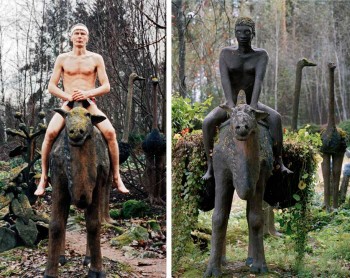
On camelback: in the exotic part of Veijo Rönkkönen’s concrete cosmos there are animals and palm trees, side by side with the living plants of the northerly latitudes. - Photo, left: Veijo Rönkkönen; right: Veli Granö.
Extracts and photographs from Veijo Rönkkösen todellinen elämä / The real life of Veijo Rönkkönen (Maahenki, 2007. Translation: Kirsti Nurmela-Knox)
Veijo Rönkkönen (born 1944) has lived all his life on an isolated, small farm in eastern Finland, Parikkala, less than a kilometre from the Russian border, where he has quietly built a garden inhabited by nearly five hundred human figures made of concrete. Entrance is free.
In this book, the photographer and writer Veli Granö introduces Rönkkönen’s work of almost half a century, pointing out that art demands to be created despite professions and careers: ‘The choices that lead one to develop into an artist are not always voluntary, nor are they necessarily made through happy coincidences. Not all artists choose this career from a vast range of possible and interesting jobs; for some it may be a kind of by-product of their battle for survival.’ Veijo Rönkkönen had to make a living by working in a pulp factory for 41 years. Making art was his way of surviving in the circumstances he was not able to choose himself.
Contemporary folk art questions the prevailing conceptions of art. For me, its most important characteristic – and the point where it most deviates from the accepted conception of art – is the total freedom it leaves for the viewer. Modern art created by professional artists is automatically labelled as ‘art’; when defining modern art, its origins are often used as a starting-point: a particular piece is modern art as long as it was produced or performed by an artist. However, some of the works in this category may seem alien to the general public. Modern art has been met with loud, sometimes overly harsh criticism. This is in accordance with the trend of extreme popularisation at work in the current cultural atmosphere. In this regard, contemporary folk art can offer a useful countercultural challenge to high art and accepted artistic practices.
One does not need to be familiar with art to understand popular or vernacular art, since it can be enjoyed with a spontaneous and playful attitude. Viewers can rank the works according to their own tastes, and they are even free to laugh at these works. Questioning the art world’s hierarchies, institutions and its particular definition of an artist can even be seen as questioning modern reason. Vernacular art brings art back to its playful, carnivalistic origins, where experience, innovation and the works of art themselves are forever developing.
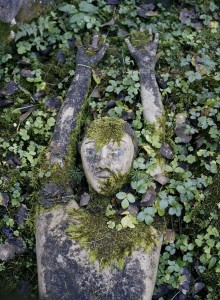
Nature conquers cement: moss gently creeps over the faces and bodies of the sculptures – nothing is eternal, art is as evanescent as its creators. – Photo: Veli Granö.
There are no superfluous items in the park – and I include the artist’s house and its contents in this – no act or thought that does not belong to, or is not clearly a part of its complex structure. The park itself is a ‘total work of art’, which compares readily to the development of the self.
Veijo’s decision to make art from concrete, one of the most durable of materials, is obviously related to the motif of the battle against time. Of course, even concrete is not immune to the ravages of time: moss sneaks onto the shoulders of the concrete peopleand lichen decorates their faces with colourful masks. The changes are slow, almost invisible, but the photographic record enables us to observe them. While the pictures of the sculptures, taken over the years, depict the tricks that the seasons and time have played, they also illustrate the drawn out decay of the works. These images of slowly ageing works form the family album of the silent sculptures.
![]()
Even if Veijo has always been keen to know the audience’s reactions, he has never talked to visitors voluntarily or asked their opinion on his work. Yet he meets people almost daily when working in his garden and never refuses to speak to them. His answers to any questions concerning the sculptures are, however, very curt so that the inquirer immediately understands his reluctance to continue the conversation.
Despite his withdrawn character, Veijo has always placed importance on the role of viewers. From indoors he observes those walking in the garden and looks for anything out of the ordinary. Should someone stray onto the flowerbeds, he will open the window and tell them to return to the path.
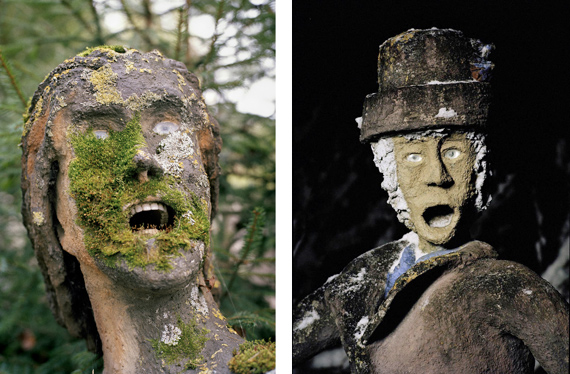
Left: Toothsome: Veijo Rönkkönen began to use dentures in his figures in 1976; ‘Javelin Thrower’ flaunts the false teeth of the artist’s father, who died in 1975. Visitors have since donated dentures to be used in Rönkkönen’s work. - Right: Concrete carnival: as visitors enter the yard, they encounter a parade of dozens of statues – women, men and children; this one is called ‘Old wife without teeth’. Veli Granö calls the parade the artist’s private carnival. - Photos: Veli Granö.
As a result of the break-up of the Soviet Union, life on the Finnish side of the border zone became a little easier. The first thing to go was the ban on stopping near the border, then the ban on using binoculars and cameras. Security cameras replaced the soldiers in the nearby watchtower. As the rules were loosened, the roadsides near the sculpture park filled with cars parked in dangerous positions. Thus for security reasons the road authority decided that a car park was required. A tourist information board and signs were erected. Since 1992, there has also been a little shop that sells refreshments and postcards of the sculpture park.
Veijo’s sculpture park is the most notable tourist attraction in Parikkala, and it is regularly advertised in various media. Numerous tourists visit the site every summer, and the busiest summer thus far saw some 26,000 visitors. Despite its status of an ‘official’ sight, Veijo has kept the park as his private garden and has nothing todo with the tourist business that surrounds him. He has no connection to the shopkeeper either, although he has paid the shop a visit at night.
His refusal to have any part in the business side arises from his overarching need to remain absolutely independent. ‘What if I decide, all of a sudden, to close up the park?’ goes his reasoning. Nevertheless, the local entrepreneurs and promoters of tourism need not be too worried. An audience is essential to Veijo, and there has never been an entrance fee, regardless of the season or the time of day. His reserved attitude towards publicity gives the sculpture park its extraordinary ambience, and the visitors can experience the dialogue between the public and the private space.
The line of statues, along with most of the other works, can be seen as Veijo’s private carnival. By turning everyday values upside down, the carnival serves as a form of therapy. The motley crew of the un-Finnish- looking figures brings medieval carnival processions to mind. It is interesting to try to figure out the origins of these strange characters. The artist himself says he simply tried to fit as many different sculptures as possible into the group.
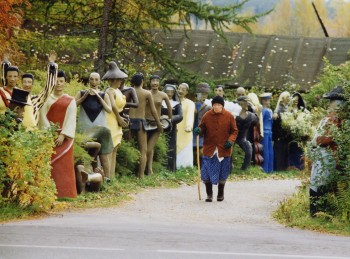
Passer-by: the artist’s mother lived with him until her death. Here she walks past the carnival figures sculpted by his son – whose work she never appreciated until he began to be recognised. - Photo: Veijo Rönkkönen.
The media and tourism have made the world a smaller place, and this shows even in the artists’ gardens. Ideas imported from exotic regions have played an important role in the western art history. As early as during the first decades of colonialism, many artists felt that lifestyle in urbanising Europe was artificial and detached from reality. Gauguin’s travels to Tahiti and the impact of African and Oceanian sculpture on the birth of European modern art in the early 20th century are well known. Incidentally, it was this same interest in the exotic that prompted the focus on Europe’s own ‘primitives’ – outsider artists and the artwork of children.
Contemporary folk art cannot be studied within the framework of art history because the makers of folk art are seldom aware of their place in the greater tradition of art. In this respect they differ from traditional rural folk artists, who closely followed the visual conventions of their communities. Art by a contemporary folk artist usually has its own evolutionary curve, dependent on the artist, and its progress dies with its maker. Veijo, too, is quite unfamiliar with art history, and it would be more fruitful to look for the aspects that his art shares with comedy, a tradition he now continues. His attempt to create an exotic ambience of the Orient in his garden should be seen purely as his own personal project, without any reference to art history.
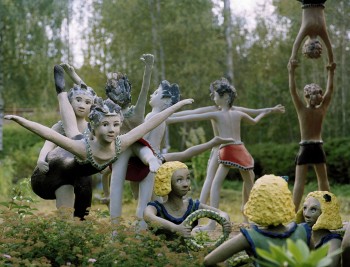
Dreams of childhood: the dozens of children in Veijo Rönkkönen’s park were all created over the past few years. They play, run, dance and fight like a tribe of small, colourful gymnasts. - Photo: Veli Granö.
Veijo’s sculpture park can be seen as a reflection of his own life. The various parts and works express the stages of his life, from growing up with the dreams and fears that he experienced, to some signs of ageing and mature giving up. In many parts, one can sense tones of a persuasive dialogue. Some of the sculptures are provocative, even aggressive, whereas others produce a sensation of thorough consideration and an aspiration to achieve spiritual harmony. The park is like a portrayal of a personality, with all its doubtful and conflicting characteristics.
So far, we have followed paths through the changing moods in the park, but paths always lead to a destination. Veijo’s sculpture park reaches its climax in the Yoga Park, which aims to portray a holistic spiritual experience. The path that leads to the heart of the park is like a trail to a mythical temple that is flanked with images of symbolic scenes, or sometimes tasks, troubles, temptations and even mazelike traps to challenge the traveller. The traditional temple path’s function is to cleanse the mind of worldly thoughts and prepare it for the experience of transcendence.
![]()
Behind Veijo’s work, we can see all those dreamers whose aim was to create life. Pygmalion is there, with the statue he made and then married; the alchemists, who wanted to create the homunculus; the Jewish mystic who made Golem out of clay; the smith Ilmarinen who forged a cold bride for himself, as well as the whole tradition of those who were punished for their hubris.
Veijo’s yearning for life and its flickering touch explains the importance of plants and natural environment in the sculpture park. Flowers and bushes give the garden the atmosphere of transience.
Many of the sculptures have a place for planting flowers. The blooming flowers in the sculptures’ embrace manage to veil the eeriness of the immobile stone. Here nature, forever changing and producing new and fantastic flowers, will soon shed its petals into the stream of life and death; it is the manifestation of the life force, it is life itself.
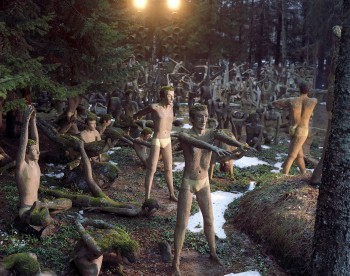
Extended self-portrait? Veijo Rönkkönen took up yoga in the 1960s, and started creating yoga figures soon after. In this Finnish back yard, the yoga park with its 250 statues is an extraordinary artistic creation. - Photo: Veli Granö.
Veijo has realised that the same vivid effect can be achieved without the gardener’s hand: if allowed, the plants push slowly up from the ground, from the roots of the statues and up along their sides. Lichen and creepers draw fresh impressions on their faces, and heavy moss capes fall gently upon their shoulders. However, these small, colourful plants can be deceptive. Their strong acidic roots corrode the sculptures’ surfaces and add to the slow process of decay. Even though Veijo would like to think that the sculptures shall remain in their place to aspire to eternal life after he is gone, he does not want to stop nature from destroying his work. He understands that his life can only continue in the process of change that he started by conquering a moment of permanence for his sculptures.
Contemporary folk art in Finland goes by the acronym ITE, from the words ‘itse tehty elämä’, a self-made, ‘DIY’ life. The French call it art brut; the English-language term is ‘outsider art’. The artists are ‘unschooled visionaries’ who make their art independent on any societal requirements or definitions. John Maizels, the British author and editor of the art magazine Raw Vision, reckons Veijo Rönkkönen as one of the masters of the outsider art.
In 2007 Veijo Rönkkönen, the artist of a self-made life, was awarded a state award, the Finland Prize, worth €30,000. More pictures: http://www.nykykansantaide.fi/veijo_ronkkonen_18.html ; click ‘Galleriaan’.
Tags: art, contemporary art, photography
1 comment:
Trackbacks/Pingbacks:
-
Veijo Rönkkösen’s Skulpturen-Garten | Feingut
7 July 2009 on 11:26 pm[…] hat einen Garten voller Beton-Skulpturen mit falschen und echten Zähnen. Hier ein Zitat aus Veli Granö’s Artikel @ Books from Finland: Veijo Rönkkönen (born 1944) has lived all his life on an isolated, small […]

3 September 2010 on 2:47 am
I visited Veijos garden several weeks ago and it was an astonishing art experience- funny, creepy and very intense. A must-see!